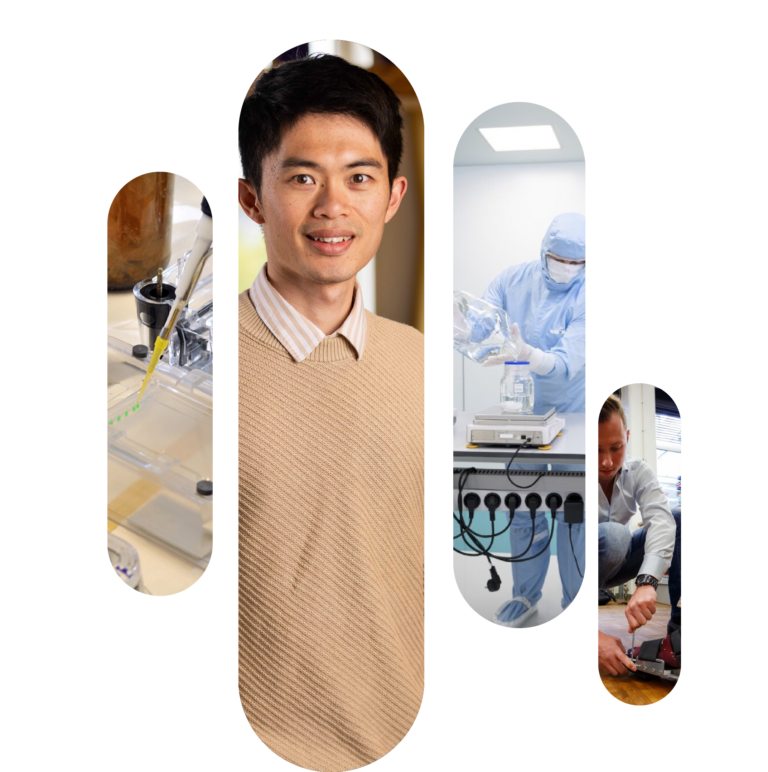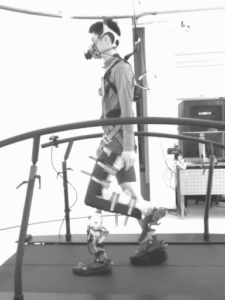
Chengxiang Liu
Lower-limb prostheses: optimal human-in-the-loop co-adaptation
After finishing my Master’s degree in Mechatronic engineering, I worked in institutes developing medical robotics for more than two years. I started my HTRIC PhD project in March 2023. This project aims at developing a human-in-the-loop approach in which the user and the (control settings and mechanical parameters of the) prosthesis co-adapt to each other in an optimization process. The research I do for this project can contribute to the life quality improvement of amputee patients.
This project is applied for by Prof. Dr. Raffaella Carloni (FSE) and Prof. Dr. Han Houdijk (UMCG).
The optimal transfemoral amputee-prosthesis co-adaptation (Co-adapt)
Let ‘s begin with an introduction of my PhD project: The optimal transfemoral amputee-prosthesis co-adaptation (Co-adapt). The project proposes to enhance the user-prothesis interaction from the perspective of co-adaptation, which takes into account the reciprocal nature of this process. The proposed approach combines the complexity and inherent unpredictability of the behavior of the user’s musculoskeletal and motor control systems.
This way, the prosthesis can incorporate the input of the amputee to find optimal control and mechanical settings for the correct human movement. Furthermore, this project aims to provide solutions to optimize the function of the powered prosthesis. With the realization of this objective, people with lower limb amputation will better accept the prosthesis, their quality of life will improve, their social contacts will be enlarged, and their (re-)integration in society and the labor market will be facilitated.
The project is based on a previous project, MyLeg (awarded by the European Union in Horizon 2020 in 2018). Hence, we have the complete mechanical structure of the prosthesis, and most of the electronic systems are ready. The rest of the work mainly focuses on control scheme development, clinical experiments, and validation.
In the past six months, I mainly worked on developing a leg prosthesis to track a predefined trajectory and tune critical parameters between the interface and the user. Further work will explore the stiffness and equilibrium effect on walking performance measured by metabolic energy and asymmetric and step length variability. After that, the user’s response to the prosthesis’ settings/parameters will be continuously assessed during gait, and iterative adaptations to these settings/parameters will be made to optimize defined cost functions related to gait performance.
Developing a prosthesis leg can sometimes be tedious and cause many setbacks. Sometimes, to fix a bug, you must spend several days going through thousands of lines of code and checking dozens of cable connections. More frustratingly, more bugs may pop out after one bug is solved. Nevertheless, when bugs are solved, the feelings of joy and reward are also with you, and the prosthesis leg works as expected. Below you can find a photo of me wearing the prosthesis leg with an adaptor.
In conclusion, I am excited about what I am doing and how the potential contribution may be made to improve the daily life quality of amputees. Please feel free to reach me if you are interested in more details about my journey in developing the prosthesis leg!
MyKnee powered variable stiffness prosthetic knee joint
Prepare to embark on a journey into the heart of innovation as we unveil the latest breakthroughs in prosthetic technology. Today, we shine a spotlight on the MyKnee powered variable stiffness prosthetic knee joint. our current endeavor lies in developing a control architecture for energy absorption and restoration during the stance period, a symphony of state machines and impedance controllers. The state machine guarantees to reliably discriminate between the stance phase, and the flexion/extension of the knee joint during the wing phase. The impedance controller tunes the variable stiffness joint and, namely, its equilibrium angular position and mechanical stiffness
To assess the impact of the impedance control and of the variation of the walking speed on the energy absorption and restoration of the prosthetic joint, we conducted a series experiments with a healthy participant wearing the MyKnee prosthetic knee joint, as shown in the figure below. We are preparing more tests with both the able-body subjects and people with a transfemoral amputation. These trials were not just tests of functionality; they were journeys of discovery, aiming to illuminate the intricate interplay between impedance control parameters and their effects on gait patterns and metabolic cost. Through the careful analysis of the experimental data, we uncovered a wealth of insights into the dynamic nature of energy storage and restoration during the stance period. We found that variations in the stiffness and equilibrium of the prosthetic knee joint, coupled with changes in walking speed, exerted a profound influence on energy absorption and restoration within the springs, as well as on knee angle variation during the stance period and metabolic cost during walking. Specifically, a greater equilibrium angle, lower stiffness, and higher walking speed correlated with enhanced energy exchange and enhanced knee flexion during the stance period.
We still don’t know what is the optimal setting of these parameters. However, these findings provide a solid foundation for further optimization and refinement, paving the way for the development of even more advanced prosthetic systems that empower individuals with a transfemoral amputation to move with confidence and grace.

Two years in prosthetic development: A journey of unexpected challenge
Two years ago, when I first took on this project, I thought developing a powered prosthetic knee joint wouldn’t be that challenging. After all, it’s just a one-degree-of-freedom system, right? Plus, with all the jaw-dropping advancements in robotics—humanoid robots performing backflips, AI-driven machines mimicking human movement—it seemed logical to assume that prosthetic technology would be just as advanced.
I couldn’t have been more wrong.
To truly understand what walking with a prosthesis feels like, I spent countless hours testing our powered prosthetic leg—binding my own knee and using a simulator to replicate the experience of a transfemoral amputee. I also had the privilege of speaking with amputees using different prosthetic legs, hearing their stories, struggles, and triumphs firsthand. And through all this, I realized something surprising: prosthetic knee technology isn’t where I expected it to be.
One of the biggest challenges lies in the way these devices move. Most powered prosthetic knees follow a time-dependent trajectory, meaning their motion is pre-programmed based on time rather than the user’s actual movement. This creates a strange and frustrating experience—like the prosthesis is walking for the user instead of with them. If the user can’t match the rigid timing of the device, their residual thigh has to fight against it, leading to unnecessary effort, discomfort, and increased metabolic energy use.
That’s where our work comes in.
Our team is developing a new control framework that moves away from rigid, time-dependent motion. Instead, we designed a time-independent trajectory based on the user’s residual thigh angle, allowing the prosthetic knee to move in sync with their natural movement. Imagine stepping forward and having the knee respond intuitively, rather than forcing you into a predefined rhythm.
We implemented this idea into a speed-adaptive control system and started testing it with able-bodied individuals using a prosthetic simulator. The journey hasn’t been smooth—every test reveals new challenges, requiring constant refinement. But one thing remains consistent: our approach significantly reduces gait asymmetry across different walking speeds compared to conventional state-machine control. And that’s a huge step forward.
There’s still a long road ahead, but every challenge brings us closer to a prosthetic knee that truly adapts to the user—not the other way around.
Stay tuned as we continue refining this technology. The future of prosthetics is evolving, and I’m excited to be part of it.
